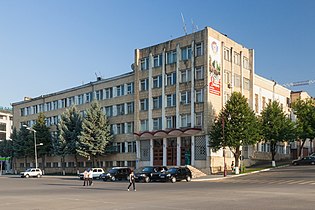| Stepanakert Armenian: Ստեփանակերտ | |
|---|---|
| City | |
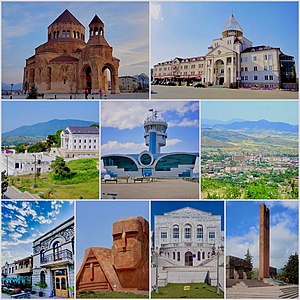 From top left: From top left: Holy Mother of God Cathedral Renaissance Square • Downtown Stepanakert Stepanakert Airport • Stepanakert skyline Park Hotel Artsakh • We Are Our Mountains Artsakh University • Stepanakert Memorial | |
 Flag Flag | |
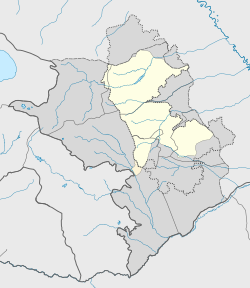 | |
| Coordinates: 39°48′55″N 46°45′7″E / 39.81528°N 46.75194°E / 39.81528; 46.75194 | |
| Country (de facto) | Artsakh |
| • Province | Stepanakert |
| City status | 1940 |
| Government | |
| • Type | Mayor–Council |
| • Body | Stepanakert City Council |
| • Mayor | David Sargsyan (2023) |
| Area | |
| • Total | 29.12 km (11.24 sq mi) |
| Elevation | 813 m (2,667 ft) |
| Population | |
| • Total | 75,000 |
| • Density | 2,600/km (6,700/sq mi) |
| Time zone | UTC+4 (GMT+4) |
| Area code | +374 47 |
| Website | stepanakert |
| Sources: Stepanakert city area and population | |
From the breakup of the Soviet Union in 1991 to the 2023 Azerbaijani offensive in Nagorno-Karabakh, the city of Stepanakert was the capital of the unrecognized breakaway Republic of Artsakh, while being internationally recognized as part of Azerbaijan.
During this period, the city was a regional center of education and culture, being home to Artsakh University, musical schools, and a Palace of Culture. The economy was based on the service industry and had varied enterprises, food processing, wine making, and silk weaving being the most important. As of 2021, the population of Stepanakert was 75,000.
Politics and government
During the period of the USSR, Stepanakert served as the capital of the Nagorno-Karabakh Autonomous Oblast within the Azerbaijani Soviet Socialist Republic, between 1923 and 1991. With the self-declared independence of Artsakh in 1991, Stepanakert continued with its status as the political and cultural centre of the newly established republic, being home to all the national institutions: the Government House, the National Assembly, the Presidential Palace, the Constitutional Court, all ministries, judicial bodies and other government organizations.
Artsakh had been a presidential republic since the 2017 constitutional referendum. The post of prime minister was abolished and executive power from then on resided with the president, who was both the head of state and head of government. The president was directly elected for a maximum of two consecutive five-year terms. The final president was Samvel Shahramanyan, in 2023.
The National Assembly was a unicameral legislature. It had 33 members who are elected for five-year terms.
The city of Stepanakert was governed by the Stepanakert City Council and the mayor of Stepanakert. The last local elections took place in September 2019. The most recent mayor was Davit Sargsyan.
Government buildings
Religion
The late-19th-century church of Vararakn was destroyed in the 1930s to build the Stepanakert Drama Theatre. Throughout the rest of the Soviet era, there were no traditional churches in Stepanakert, although most of the population of the city were members of the Armenian Apostolic Church.
The church of Surp Hakob (or Saint James) was opened in 2007; it remained the only open church in the city until 2019. The church was financed by Nerses Yepremian from Los Angeles. The church was consecrated on 9 May 2007, in honor of the 15th anniversary of the capture of Shusha by Armenian forces.
The construction of the Holy Mother of God Cathedral was launched on 19 July 2006. The cost of the project was expected to be around US$2 million and the architect of the church is Gagik Yeranosyan. However, the construction process was slow due to a lack of financial resources. The inauguration of the church was expected to take place in September 2016. Construction finished and the church was opened in 2019.
There was small community of Armenian Evangelicals with around 500 members. The only Armenian evangelical church in Artsakh is located in Stepanakert. The Evangelical community supported many schools, hospitals and other institutions through the help of the Armenian Diaspora.
Transport


Bus
Stepanakert was served by a number of regular minibus lines. Old Soviet-era buses had been replaced with new modern buses. Regular trips to other provinces of Nagorno-Karabakh were also operated from the city.
Air
Stepanakert was served by the nearby Stepanakert Airport, north of the city near the village of Ivanyan. In 2009, facilities reconstruction and repair work began. Though originally scheduled to launch the first commercial flights on 9 May 2011, Karabakh officials postponed a new reopening date throughout the whole of 2011. In May 2012, the director of the NKR's Civil Aviation Administration, Tigran Gabrielyan, announced that the airport would begin operations in summer 2012. However, the airport still remains closed due to political reasons. The OSCE Minsk Group, which mediates the Nagorno-Karabakh conflict, stated that "operation of cannot be used to support any claim of a change in the status of Nagorno-Karabakh" and "urged the sides to act in accordance with international law and consistent with current practice for flights over their territory."
Economy
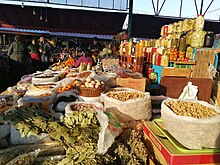
The city was a regional center of education and culture, being home to Artsakh University, musical schools, and a Palace of Culture. The economy was based on the service industry and had varied enterprises, food processing, wine making, and silk weaving being the most important. As of 2021, the population of Stepanakert was 75,000.
Stepanakert was the center of the economy of Artsakh. Prior to the First Nagorno-Karabakh War, the economy of Stepanakert was mainly based on food-processing industries, silk weaving and winemaking. Inhabitants also engaged in producing furniture and footwear. The economy was severely damaged due to the 1988 earthquake in Armenia and the First Nagorno Karabakh war. In the years following, the economy was developed further, mainly due to investments from the Armenian diaspora. However, following the 2020 Nagorno-Karabakh war, the economy once again experienced severe damage, particularly in the tourism sector.
The most developed sectors of Stepanakert and the rest of the Republic of Artsakh are tourism and services. Several hotels were opened by diasporan Armenians from Russia, the United States and Australia. Artsakhbank was the largest banking services provider in Artsakh, while Karabakh Telecom was the leading provider of mobile telecommunications and other communication services.
Stepanakert was also home to many large industrial firms, including Stepanakert Brandy Factory, Artsakh Berry food products and Artsakh Footwear Factory.
Construction was also one of the leading sectors in the city. Artsakh Hek was the leading construction firm, while Base Metals was the leader in mining and production of building materials.
Culture
| This article needs to be updated. Please help update this article to reflect recent events or newly available information. (October 2023) |

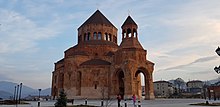
The Vahram Papazyan Drama Theater of Stepanakert was founded in 1932. In 1967, the monumental complex of Stepanakert known as We Are Our Mountains was erected to the north of Stepanakert, It is widely regarded as a symbol of the Armenian heritage of the historic Artsakh. After the independence of Armenia, many cultural and youth centres were reopened. The cultural palace of the city is named after Charles Aznavour.
Stepanakert was home to the Mesrop Mashtots Republican Library opened in 1924, Artsakh History Museum opened in 1939, Hovhannes Tumanyan Children's Library opened in 1947, Stepanakert National Gallery opened in 1982, and the Memorial Museum of the Martyred Liberators opened in 2002. A new cultural complex of the Armenian heritage of Artsakh was under construction.
The Artsakh State Museum, based in Stepanakert, had an important collection of ancient artifacts and Christian manuscripts.
Education
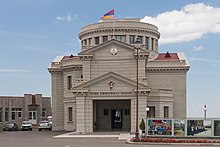
Stepanakert was the center of higher education in Artsakh. Five higher educational institutions operated in the city:
- Artsakh State University, founded in 1969 as a branch of the Baku Pedagogical Institute. In 1973, it was renamed Stepanakert Pedagogical Institute and following the independence of Nagorno-Karabakh, in 1992, it received its current status. The university offered courses spread across seven departments and has 4,500 students.
- Stepanakert campus of the Armenian National Agrarian University.
- Grigor Narekatsi University (private).
- Mesrop Mashtots University (private).
- Gyurjyan Institute for Applied Arts (private).
Many new schools in Stepanakert were opened from the late 1990s to 2010 with the help of the Armenian diaspora. Existing schools were also renovated with donations from the diaspora.
The Stepanakert branch of Tumo Center for Creative Technologies was opened in September 2015, as a result of continued cooperation between the Tumo Centre and the Armenian General Benevolent Union, with the support of mobile operator Karabakh Telecom.
Sport

Football is a popular sport in Nagorno-Karabakh and the city has a renovated football stadium. Since the mid-1990s, football teams from Karabakh started taking part in some domestic competitions in Armenia. Lernayin Artsakh is the football club that represents the city of Stepanakert. The Artsakh national football league was launched in 2009.
The non-FIFA affiliated Artsakh national football team was formed in 2012 and played their first competitive match against the unrecognized Abkhazia national football team in Sukhumi on 17 September 2012. The match ended with a 1–1 draw. The following month, on 21 October 2012, Artsakh played the return match at the Stepanakert Republican Stadium against Abkhazia, winning it with a result of 3–0.
There was also interest in other sports, including basketball and volleyball.
Artsakh athletes also took part with the representing teams and athletes in the Pan-Armenian Games, organized in Armenia.
As an unrecognized entity, the athletes of Artsakh competed in international sports competitions under the flag of Armenia.
Twin towns – sister cities
Main article: List of twin towns and sister cities in the Republic of ArtsakhStepanakert was twinned with:
- Montebello, United States: On 25 September 2005, Montebello, California and Stepanakert became sister cities. This prompted a complaint by the ambassador of Azerbaijan to the United States, Hafiz Pashayev, who sent a letter to California leaders, stating that the decision jeopardized peace talks between his country and Armenia. The letter was sent to then-California governor Arnold Schwarzenegger, who deferred the letter to Montebello mayor Bill Molinari since it concerned a local, not a state, issue. Molinari responded to Pashayev that the city would go ahead with its plans to inaugurate Stepanakert under the sister city program. Stepanakert's relationship with Montebello is aimed at revitalizing the capital's economic infrastructure and building cultural and educational ties, as well as developing trade and health care between the two cities. Azerbaijan has described this as a contradictory foreign policy of the United States that supports the NKR government and Armenian aggression against Azerbaijan.
- Mairiporã, Brazil: Since June 18, 2018, Law 3767/18 has made Eternal Armenia the name that declares Sister Cities the Municipalities of Mairiporã, State of São Paulo, and Stepanakert, capital of the self-declared Nagorno-Karabakh Republic which triggered an alert from Itamaraty, Brazilian Ministry of Foreign Affairs, on the attitude of the Municipality as Brazil does not recognize the independence of Nagorno-Karabakh.
Friendship declarations
- On 22 May 1998, Stepanakert and the commune of Villeurbanne in France signed a Friendship Declaration.
- On 28 September 2012, Stepanakert and Yerevan, Armenia, the capitals of the two Armenian republics, became friends after signing a partnership agreement.
- On 15 September 2014, San Sebastián, Spain, and Stepanakert signed a cooperation agreement.
- On 17 May 2015, Stepanakert and the commune of Valence in France signed a Friendship Declaration.
- On 3 February 2016, Stepanakert signed a Friendship Declaration with the municipality of Franco da Rocha, Brazil.
- On 23 July 2019, Stepanakert signed a Friendship Declaration with the City of Ryde, Australia.
Notes
References
- Hewsen 2001, p. 265
- "Figures" (PDF). stat-nkr.am. 2015. Archived (PDF) from the original on 12 September 2020. Retrieved 12 April 2016.
- "General Characteristics of the NKR" (PDF). Archived (PDF) from the original on 29 September 2015. Retrieved 16 September 2015.
- ^ Baranchikov 2016, p. 225
- ^ Khachatryan, Karen (13 August 2021). Stepan Kocharyan (ed.). "Drought leads to "unprecedented" water crisis in Stepanakert city". armenpress.am. Stepanakert: Armenpress. Archived from the original on 2 July 2022. Retrieved 18 December 2021.
- "President of the ARTSAKH REPUBLIC – Biography". president.nkr.am. 2023-06-17. Archived from the original on 2023-06-10.
- "National Assembly". Nkrusa.org. The Office of the Nagorno Karabakh Republic in USA. Retrieved 18 December 2021.
- Sanamyan, Emil (2019-09-09). "Artsakh Elects Mayors and Municipal Councils". USC Institute of Armenian Studies. Archived from the original on 17 June 2023. Retrieved 2023-06-17.
- "Ստեփանակերտի քաղաքապետարան – Քաղաքապետ". www.stepanakert.am (in Armenian). 2023-06-17. Archived from the original on 2023-04-14.
- Kiesling & Kojian 2005, p. Stepanakert
- Grigorian, Laura (10 May 2007). "ST JAMES CHURCH WAS OPENED IN STEPANAKERT". Armenian News. Archived from the original on 4 April 2012.
- "The church of Stepanakert". www.stepanakert-church.org. Archived from the original on 7 October 2018. Retrieved 18 November 2015.
- "The construction of Stepanakert Cathedral is at its final stages". Archived from the original on 19 November 2015.
- "Official ceremony of consecration and opening Cathedral of Intercession takes place in Stepanakert". news.am. Archived from the original on 8 April 2019. Retrieved 2019-05-16.
- Ghanalanyan, Tigran (9 June 2012). "Activity of the Armenian Evangelicals in Artsakh". noravank.am. Center for the Armenian Studies, "Noravank" Foundation. Archived from the original on 18 December 2021. Retrieved 18 December 2021.
- Holding 2006, p. 208
- "Karabakh To Reopen Stepanakert Airport". Asbarez. 5 October 2010. Archived from the original on 17 January 2013. Retrieved 11 October 2010.
- "Nagorno-Karabakh Flights On Hold Despite Airport Reconstruction". Radio Free Europe/Radio Liberty. 16 May 2011. Archived from the original on 18 May 2011. Retrieved 16 May 2011.
- (in Armenian) "«Հայկական ժամանակ».Ստեփանակերտի օդանավակայանը վերջապես շահագործման կհանձնվի Archived 2 January 2014 at the Wayback Machine" . Yelaket Lratvakan. 30 May 2012.
- Statement of the OSCE Minsk Group Co-Chairs Archived 22 January 2013 at the Wayback Machine.
- Mkrtchyan 1985, pp. 124–125
- Lagasse 2000
- Nahapetyan, Haykaram (10 July 2021). "Artsakh's Economy: The Post-war Syndrome and Recovery Efforts". The Armenian Mirror-Spectator. Watertown: Baikar Association. Archived from the original on 22 December 2021. Retrieved 22 December 2021.
- Hayrumyan, Naira. "Recovery and Concern: Regional Unrest Reminds of NKR's Years of Progress While Raising Anxiety Archived 22 September 2010 at the Wayback Machine." AGBU Magazine. Vol. 18, № 2, November 2008, pp. 34–37.
- Holding 2006, p. 210
- Chorbajian 2001, p. 140
- "Artsakh president attends Aznavour commemoration event in Stepanakert". Tert.am. 6 October 2018. Archived from the original on 20 December 2021. Retrieved 20 December 2021.
- "Ստեփանակերտի մէջ նոր յուշահամալիր կը կառուցուի – Azat Or". 17 March 2017. Archived from the original on 22 March 2017. Retrieved 21 March 2017.
- "MUSEUMS – Karabakh Travel". artsakh.travel. Tourism department of ministry of economy of NKR. Archived from the original on 2018-04-06. Retrieved 2018-04-06.
- (in Armenian) Anon. "ԱՐՑԱԽԻ ՊԵՏԱԿԱՆ ՀԱՄԱԼՍԱՐԱՆ (Arts'akhi Petakan Hamalsaran, Artsakh State University) Archived 27 September 2011 at the Wayback Machine." Azat Artsakh. 29 August 2006. Retrieved 4 September 2009.
- "VALERY A. ALEXANYAN". nankr.am. Official website of the National Assembly of the Republic of Artsakh (Nagorno-Karabakh). Archived from the original on 20 December 2021. Retrieved 20 December 2021.
- ^ Vardanian 2009, p. 45
- "Armenia Fund Opens 600-Student School in Stepanakert Archived 23 July 2011 at the Wayback Machine." Asbarez. 14 September 2010. Retrieved 4 December 2010.
- "No. 9 School, Stepanakert". armeniafund.org. Armenia Fund. Archived from the original on 21 December 2021. Retrieved 21 December 2021.
- "Tumo Center Opens in Stepanakert". Asbarez. 1 September 2015. Archived from the original on 6 October 2017. Retrieved 8 October 2017.
- "Stepanakert "Tumo" Center is planned to be launched in September". Armenpress. 13 August 2015. Archived from the original on 18 November 2015. Retrieved 8 October 2017.
- ^ O'Connor, Robert (20 April 2017). "Football and hope in the Nagorno-Karabakh Republic – a forgotten region fighting Fifa's sanctions". The Independent. Stepanakert: Independent Digital News & Media Ltd. ISSN 0951-9467. Archived from the original on 20 December 2021. Retrieved 20 December 2021.
- (in Armenian) "Աբխազիայի ու Արցախի հավաքականները բաժանվեցին խաղաղությամբ՝ 1:1 Archived 8 November 2014 at the Wayback Machine ," Tert.am 25 September 2012. Retrieved 7 November 2012.
- "Armenia's newly formed second national football team to face Abkhazia Archived 17 October 2017 at the Wayback Machine." News.am 14 September 2012.
- "Asbarez.com Artsakh Soccer Team Beats Abkhazia 3-0 Archived 25 December 2012 at the Wayback Machine." Asbarez. 22 October 2012.
- Harutyunyan, Aneta (2 August 2019). "Artsakh ready for the opening of 7th Pan-Armenian Games". Yerevan: Armenpress. Archived from the original on 2 July 2022. Retrieved 21 December 2021.
- ^ Wright, Pam. "Montebello's newest Sister City program has come under fire from an ambassador for the Republic of Azerbaijan." Whittier Daily News. 19 November 2005. Retrieved 2 August 2007.
- "Azeri pressure group appeals to US envoy over twinning reports." BBC News in BBC Monitoring Central Asia. 24 November 2005. Retrieved 2 August 2007.
- LLC, Helix Consulting (February 2019). "Leis aprovadas em SP levam Itamaraty a alertar cidades sobre mal-estar com o Azerbaijão". www.g1.com.br. Archived from the original on 1 January 2020. Retrieved 1 January 2020.
- ^ "International Cooperation | NKR". Archived from the original on 1 March 2021. Retrieved 9 October 2019.
- "Partner cities". Yerevan. Archived from the original on 19 August 2014. Retrieved 2020-06-25.
- LLC, Helix Consulting. "Stepanakert, Donostia sign cooperation agreement". www.panorama.am. Archived from the original on 24 September 2015. Retrieved 6 November 2014.
- LLC, Asbarez. "Australia's Ryde Forms Friendship City with Stepanakert". www.asbarez.com. Archived from the original on 24 July 2019. Retrieved 24 July 2019.
Bibliography
- Adalian, Rouben Paul (2010). Historical Dictionary of Armenia (2 ed.). Lanham, Toronto, Plymouth: Rowman & Littlefield. p. 553. ISBN 9780810874503.
- Baranchikov, E.V. (2016). "STEPANAKERT". In Yuri Osipov (ed.). Great Russian Encyclopedia (in Russian). Vol. 31. Moscow. p. 225. ISBN 978-5-85270-367-5.
{{cite encyclopedia}}: CS1 maint: location missing publisher (link) - Busse, H. (1983). "ABU'L-FATḤ KHAN JAVĀNŠĪR". In Ehsan Yarshater (ed.). Encyclopædia Iranica. Vol. I (3 ed.). New York. pp. 285–286. ISBN 978-0710090928.
{{cite encyclopedia}}: CS1 maint: location missing publisher (link) - Chorbajian, Levon (2001). The Making of Nagorno-Karabagh: From Secession to Republic. New York: Palgrave Macmillan. p. 140. ISBN 9780230508965.
- Davies, Norman (2017). Beneath Another Sky: A Global Journey Into History. United Kingdom: Penguin Books Limited. ISBN 9781846148323.
- de Waal, Thomas (2013). Black Garden: Armenia and Azerbaijan Through Peace and War. NYU Press. ISBN 9780814785782.
- Everett-Heath, John (2019). The Concise Dictionary of World Place Names (5 ed.). United Kingdom: Oxford University Press. ISBN 9780192556462.
- Hagobian, Hagob Melik; Melkonian, Ara Stepan (2020). The Five Melikdoms of Karabagh. Yerevan: Gomidas Institute. ISBN 9781909382602.
- Hakobyan, Tadevos Kh.; Melik-Bakhshyan, Stepan T.; Barseghyan, Hovhannes Kh. (1998). Հայաստանի և հարակից շրջանների տեղանունների բառարան [Dictionary of Toponyms of Armenia and Adjacent Territories] (in Armenian). Vol. 4. Yerevan State University Press. p. 773. OCLC 247335945.
- Hewsen, Robert H. (2001). Armenia: A Historical Atlas. Chicago: University of Chicago Press. p. 265. ISBN 0-226-33228-4.
- Holding, Deidre; Allen, Tom (2019). Armenia: With Nagorno Karabagh (5 ed.). United Kingdom: Bradt. ISBN 9781784770792.
- Holding, Nicholas (2006). Armenia with Nagorno Karabagh (2 ed.). London: Bradt. ISBN 1-84162-163-3.
- Ismail-Zadeh, D. (1976). "Русские поселения в Закавказье в 30-х — 80-х годах XIX века" [Russian settlements in Transcaucasia in the 30s–80s of the 19th century]. Voprosy Istorii (in Russian). Moscow: Russian Academy of Sciences: 20. ISSN 0042-8779.
- Kaufman, Stuart (2001). Modern Hatreds: The Symbolic Politics of Ethnic War. New York: Cornell Studies in Security Affairs. p. 61. ISBN 0-8014-8736-6.
- Kiesling, Brady; Kojian, Raffi (2005). "Stepanakert". Rediscovering Armenia : an archaeological/touristic gazetteer and map set for the historical monuments of Armenia (2 ed.). Yerevan: Matit. ISBN 9789994101214.
- King, David C.; Nevins, Debbie (2020). Azerbaijan. New York: Cavendish Square. p. 7. ISBN 9781502658715.
- Kocharyan, G. A. (1925). Nagorno-Karabakh. Baku: Society for Survey and Study of Azerbaijan. p. 46.
- Kuciukian, Pietro (2003). "Capitolo ottavo : La città di Stefano". Giardino di tenebra : viaggio in Nagorno Karabagh [Garden of Darkness: Journey to Nagorno Karabakh]. Milan: Guerini e Associati. pp. 1000–1005. doi:10.1400/41657. ISBN 9788881952854.
- Kuliev, Jemil (1987). "Khankendi". Azerbaijani Soviet Encyclopedia (in Azerbaijani). Vol. 10. Baku: Azerbaijan National Academy of Sciences.
- Lagasse, Paul (2000). "Khankendi". The Columbia Electronic Encyclopedia. Vol. 1 (6 ed.). New York: Columbia University Press. OCLC 746941797.
- Lobell, Steven E.; Mauceri, Phillip (2004). Ethnic Conflict and International Politics: Explaining Diffusion and Escalation. New York: Palgrave MacMillan. p. 58. ISBN 1-4039-6356-8.
- Mkrtchyan, Shahen (1985). "Stepanakert". In Viktor Ambartsumian (ed.). Armenian Soviet Encyclopedia (in Armenian). Vol. 11. Yerevan: Academy of Sciences of the Armenian SSR. pp. 124–125. OCLC 22420067.
- Mutafian, Claude; Chorbajian, Levon; Donabédian, Patrick (1994). "Karabagh in the Twentieth Century". The Caucasian Knot: The History & Geopolitics of Nagorno-Karabagh. London and New Jersey: Zed Books. p. 139. ISBN 9781856492881.
- New York, American Geographical Society of (1988). Soviet Geography. Vol. 29. United States: Scripta Publishing Company. p. 80.
- Payaslian, Simon (2008). The History of Armenia: From the Origins to the Present. New York: Palgrave Macmillan. p. 174. ISBN 978-0-230-60858-0.
- Prokhorov, Alexander (1977). "Stepanakert". Great Soviet Encyclopedia (3 ed.). Moscow: Sovetskaya Entsiklopediya. OCLC 14476314.
- Saparov, Arséne (2012). "Why Autonomy? The Making of Nagorno-Karabakh Autonomous Region 1918–1925" (PDF). Europe-Asia Studies. 64 (2). Routledge: 281–323. doi:10.1080/09668136.2011.642583. S2CID 154783461.
- Uhlig, Mark A. (1993). "The Karabakh war". World Policy Journal. 10 (4). New York: Duke University Press: 47–52. ISSN 0740-2775. JSTOR 40209334.
- Vardanian, Manuk (2009). Атлас Нагорно-Карабахской Республики [Atlas Nagorno-Karabakh Republic] (in Russian). Yerevan: GNO "Center for Geodesy and Cartography". p. 45. ISBN 9789994103362.
- Zubkova, Elena Yurievna (2004). "Власть и развитие этноконфликтной ситуации в СССР. 1953-1985 гг" [Power and Development of the Ethno-Conflict Situation in the USSR]. Russian History (in Russian) (4). Moscow: Nauka: 22. ISSN 0869-5687.
External links
- Stepanakert Municipality (hy)
- 360 Panoramic view of the City Center (en)
- Artsakh tourism Office (en) Archived 24 October 2020 at the Wayback Machine
- Stepanakert on Lonely Planet (en)
- Stepanakert in the Republic of Artsakh at GEOnet Names Server
| Links to related articles | |||||||||||||||||||||||||||||||||||||||||||||||||||||||||||||||||||||||||||||||||||||||
|---|---|---|---|---|---|---|---|---|---|---|---|---|---|---|---|---|---|---|---|---|---|---|---|---|---|---|---|---|---|---|---|---|---|---|---|---|---|---|---|---|---|---|---|---|---|---|---|---|---|---|---|---|---|---|---|---|---|---|---|---|---|---|---|---|---|---|---|---|---|---|---|---|---|---|---|---|---|---|---|---|---|---|---|---|---|---|---|
| |||||||||||||||||||||||||||||||||||||||||||||||||||||||||||||||||||||||||||||||||||||||
| Administrative divisions of Artsakh | ||
|---|---|---|
| Capital city | ||
| Provinces | ||
| Provincial capitals | ||
| Other urban communities |
| |


